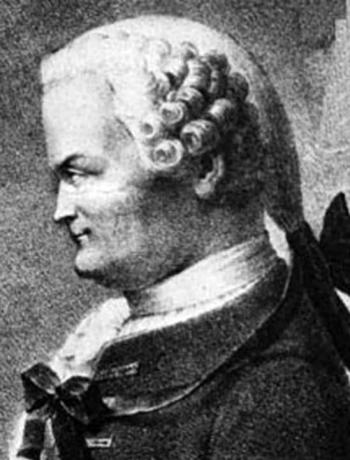<Back to Index>
- Mathematician Johann Heinrich Lambert, 1728
- Poet Guillaume Apollinaire, 1880
- Prime Minister of the United Kingdom Sir Robert Walpole, 1st Earl of Oxford, 1676
PAGE SPONSOR

Johann Heinrich Lambert (August 26, 1728 – September 25, 1777) was a Swiss mathematician, physicist and astronomer.
Lambert was born in 1728 in the city of Mulhouse (now in Alsace, France) which at that time was an exclave of Switzerland. Leaving school he continued to study in his free time whilst undertaking a series of jobs: assistant to his father (a tailor), a clerk at a nearby iron works, a private tutor, secretary to the editor of Basler Zeitung and, at the age of 20, private tutor to the sons of Count Salis in Chur. Travelling Europe with his charges (1756 – 1758) allowed him to meet established mathematicians in the German states, The Netherlands, France and the Italian states. On his return to Chur he published his first books (on optics and cosmology) and began to seek an academic post. After a few short posts he was rewarded (1764) by an invitation from Euler to a position at the Prussian Academy of Sciences in Berlin, where he gained the sponsorship of Frederick II of Prussia. In this stimulating, and financially stable, environment he worked prodigiously until his death in 1777.
Lambert was the first to introduce hyperbolic functions into trigonometry. Also, he made conjectures regarding non-Euclidean space. Lambert is credited with the first proof that π is irrational in 1768. Lambert also devised theorems regarding conic sections that made the calculation of the orbits of comets simpler.
Lambert devised a formula for the relationship between the angles and the area of hyperbolic triangles. These are triangles drawn on a concave surface, as on a saddle, instead of the usual flat Euclidean surface. Lambert showed that the angles cannot add up to π (radians),
or 180°. The amount of shortfall, called defect, is proportional to
the area. The larger the triangle's area, the smaller the sum of the
angles and hence the larger the defect CΔ = π — (α + β + γ). That is,
the area of a hyperbolic triangle (multiplied by a constant C) is equal
to π (in radians), or 180°, minus the sum of the angles α, β, and
γ. Here C denotes, in the present sense, the negative of the curvature of
the surface (taking the negative is necessary as the curvature of a
saddle surface is defined to be negative in the first place). As the
triangle gets larger or smaller, the angles change in a way that
forbids the existence of similar hyperbolic
triangles, as only triangles that have the same angles will have the
same area. Hence, instead of expressing the area of the triangle in
terms of the lengths of its sides, as in Euclid's geometry, the area of
Lambert's hyperbolic triangle can be expressed in terms of its angles. Lambert was the first mathematician to address the general properties of map projections.
In particular he was the first to discuss the properties of
conformality and equal area preservation and to point out that they
were mutually exclusive. In 1772 Lambert published seven new map projections under the title Anmerkungen und Zusätze zur Entwerfung der Land- und Himmelscharten, (Notes and Comments on the Composition of Terrestrial and Celestial Maps). Lambert did not give names to any of his projections but they are now known as: The first three of these are of great importance.
Lambert invented the first practical hygrometer. In 1760, he published a book on light reflection, the Photometria, in which he formulated the law of light absorption — the Beer–Lambert law). Lambert also wrote a classic work on perspective and also contributed to geometrical optics. The photometric unit lambert is named in recognition of his work in establishing the study of photometry.
In his main philosophical work, New Organon (1764), Lambert studied the rules for distinguishing subjective from objective appearances. This connects with his work in the science of optics.
Lambert also developed a theory of the generation of the universe that was similar to the nebular hypothesis that Thomas Wright and Immanuel Kant had (independently) developed. Wright published his account in An Original Theory or New Hypothesis of the Universe (1750), Kant in Allgemeine Naturgeschichte und Theorie des Himmels,
published anonymously in 1755. Shortly afterward, Lambert published his
own version of the nebular hypothesis of the origin of the solar system in Cosmologische Briefe über die Einrichtung des Weltbaues (1761). Lambert hypothesized that the stars near the sun were part of a group which travelled together through the Milky Way, and that there were many such groupings (star systems) throughout the galaxy. The former was later confirmed by Sir William Herschel.